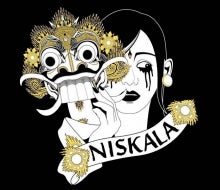Juxtaposing Ideologies in Niskala

In Bali, the word Niskala defines a praxis involving the occult. More often described in contexts with its counterpart, Sekala, the two terms interlock to evoke the liminal state between the intangible and tangible world, respectively. It is at the crux of Balinese philosophy and ceremony that defines its cosmology. Thus, Niskala is often interpreted as a safe haven of ideological exigency. My interests for this project lie between two musics: a sub-sect of the metal genre, math-metal (also under the alias of progressive metal) and processional gamelan from Bali called baleganjur. In discussing the performative purpose, these two genres are conflicting. One uses ‘dark’ and ‘negative’ culture as a mode of composition and communal creation (metal) and the other is performed specifically to dispel or ward away evil spirits (gamelan baleganjur). Why then, do these two practices share inherent musical features? Both genres are loud, brash, and rhythmically technical among other, non-musical, intersections. This study researches musical hybridity as a locus of juxtaposing ideology, particularly at the production of like-sounding musics. I use a gamelan math-metal band, Niskala (U.K.), as a case study; looking specifically at the musical devices shared by gamelan baleganjur and math-metal that confirms ideology and provides a safe haven for conflicting principles.
Bridging Baleganjur and Math-Metal: Niskala, U.K.
In the summer of 2011, I found myself back in Bali for summer vacation, but also to help run the family sanggar (Balinese arts commune), Manik Galih. Run by my mother and father, Bapak I Made Lasmawan and Ibu Ni Ketut Marni, whom are Indonesian arts teachers, Sanggar Manik Galih afforded students with an opportunity to study Balinese culture in a localized village context far away from the more globalized, tourist driven cities. This also happened to be the year that the sanggar was officially established and gamelan math-metal band, Niskala, was born. I met the creator of Niskala, Luke Geaney, during his stay with our family. He had encountered a gentleman at a party in England who happened to be Pak Made Lasmawan’s old student. This gentleman recommended the stay at the sanggar and the following year, Geaney was in Bali. Along with about twenty other college students, Geaney took classes in music, dance, wood carving, and studies in religion. Being a drummer himself, we found a way to dig up my old, dusty, drumset and shred drum licks. Inevitably, we found the rest of the compound frequently yelling, “Be quiet!” to the sounds of heavy-metal grooves. During this disseminated quiet time, we found ourselves discussing our shared affinities for metal music and gamelan.
This condensed anecdote highlights the impact of shared music and the beginnings of new musical practices. I chose to share this particular story to account for the fact that out of Niskala’s seven members, Luke Geaney is the only one that has been to Bali; a faction of study that is integral to analyzing Niskala’s music.
Although Niskala’s aesthetic is reminiscent of Balinese musical sensibilities, none of the members are Balinese. Comprised of seven members (and still expanding) from the surrounding Manchester area, Niskala utilizes a dismembered rock instrumentation with traditional Balinese instruments; primarily found in gamelan baleganjur called ceng-ceng kopyak (processional cymbals) and tawa-tawa (bronze kettle pot used to keep a pulse). In a typical rock band, the drumset is played by one person and is fairly conventional in configuration: snare drum, bass drum, tom-toms, and an array of cymbals. Niskala has divided their drumset to be used by two people, with the omission of drumset cymbals. The rest of the band includes two electric guitar players, two ceng-ceng players, an electric bassist, and a vocalist. This particular set-up provides the tools for a loud yet crisp use of complex musical noise.
Not only is rhythmic syncopation a key feature and integral mode of composition that ties math-metal and gamelan baleganjur together, but the use of kotekan (rhythmic and melodic interlocking) produces the convolved sound of cohesion. Kotekan is a system of hocketing that accounts for why Niskala decided to dismember the drumset. Both math-metal and gamelan baleganjur are rhythmically complex with an air of through-composition in the midst of cyclicity. This means that the rhythmic phrasings are asymmetrical within the larger foundation of a symmetrical musical repetition. What defines their unique compatibility is the idea that performers negotiate space with different textures in very micro-scaled temporality. This is what kotekan evokes when performing at high tempi. Niskala’s mixture of beautifully brash music also connote an embodiment of their physically carnivalesque costuming.
Topeng in Bali is translated to masked arts. Specifically, it involves a performativity of dancing ascribed to shamanism. It engages the concept of niskala to evoke and communicate with intangible realities. Often times, topeng characterizes an individual archetype found in Balinese mythology or society that portray a humanistic or divine quality. All of the members in Niskala perform with topeng masks assuming a character in the ensemble. Not unlike a popular trend in metal music, the hyper-reality delegated by the artists constitute a realm of playfulness that forms the ideological safe-haven.

Examples of topeng masks
Dispelled Darkness: Juxtaposition of ideology
Musically, gamelan baleganjur and math-metal share sonic qualities that necessarily define their formative structure. Why then do juxtaposing ideologies gravitate toward one another? Does the spectrum of polarity invite a philosophical clamor? I am inclined to suggest that this phenomenon would not occur without an ontology of deviancy. There must be something inherent in the musical properties that render the intentions ostensible. It is merely a product of communal cohesion through an air of exile. Metal in particular harbors community of exiles from the normative societal pool (I should know because I was one). The inviting sounds of gamelan baleganjur attracts first, then steers away from normalcy. This is different than the conventional notion of baleganjur merely warding off or dispelling evil spirits. Musical hybridity as a safe haven for juxtaposing ideology does not presume the oversight of problems likely to surface, but rather forms a praxis of play that includes a developing exigency for knowledge. It is a way to efficiently delve into cultures that are at the margins. Niskala is a band in infancy with a healthy growing artistic muse. Their stamp on metal music and gamelan as a whole, designate the placelessness of contemporary music and thought that examines a transitioning practice and ultimately, a new era.
References
Bakan, Michael B. 1999. Music of Death and New Creation: Experiences in the World of Balinese Gamelan Beleganjur. Chicago: University of Chicago Press.
Eisman , Fred B. 1990. Bali: Sekala and Niskala. Vol. 1, Essays on Religion, Ritual, and Art. Tokyo: Tuttle.
McGraw, Andrew Clay. 2013. Radical Traditions: Reimagining Culture in Balinese Contemporary Music. New York: Oxford University Press.





